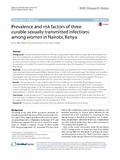Prevalence and risk factors of three curable sexually transmitted infections among women in Nairobi, Kenya

View/
Date
2016-03Author
Maina, Anne Njeri
Kimani, Joshua
Anzala, Omu
Type
ArticleLanguage
enMetadata
Show full item recordAbstract
Background
Sexually transmitted infections (STIs) are a major public health problem, especially in developing countries. The complications of untreated STIs in the female genital tract and their role in adverse pregnancy and perinatal outcomes have been well documented. The prevalence of STIs in Kenya among women in the general population has not been extensively studied and there is a lack of guidelines for screening of non-pregnant women. Knowledge of the prevalence of curable STIs among this population can provide a basis for integrating STI screening in family planning clinics.
Methods
A cross-sectional study was conducted between May and September 2013 at the family planning (FP) clinic at Kenyatta National Hospital (KNH) in Nairobi, Kenya. A total of 261 participants aged 18–49 years were enrolled; with data from 249 participants being analysed. An interviewer-administered questionnaire was used to gather socio-demographic data and assess for risk factors. Each participant was screened for Trichomonas vaginalis (TV) by wet mount microscopy; Neisseria gonorrhoeae (GC) by culture and Chlamydia trachomatis (CT) by PCR.
Results
The prevalence of CT was 13 % (33/249), TV 0.4 % (1/249) and GC 0 % (0/249). All the infected women reported having had only one sexual partner in the previous 1 year. The age group prevalence for CT was highest in the 25–29 years age group (21 %). The syndromic approach to the management of STIs showed a low specificity (vaginal discharge, 65.7 %; lower abdominal pain, 60.6 %) and positive predictive value (vaginal discharge, 14 %; lower abdominal pain, 11.5 %) for the two commonly used symptoms when compared to the gold standard of CT PCR.
Conclusion
A high prevalence of CT was identified among women attending the FP Clinic at KNH. The study reinforces the need to implement regular screening for STIs among FP clinic attendants. It also reveals the need to review the usage of the syndromic approach for the management of STIs.
Citation
Maina, A. N., Kimani, J., & Anzala, O. (2016). Prevalence and risk factors of three curable sexually transmitted infections among women in Nairobi, Kenya. BMC Research Notes, 9(1), 1.Publisher
http://www.ncbi.nlm.nih.gov/pmc/articles/PMC4812604/
